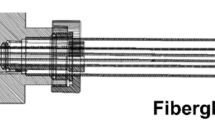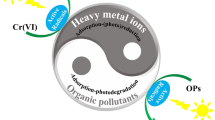Abstract
The important role of oxygen-containing groups of porous carbonaceous materials (PCMs) on sorption of organic compounds has been realized, but whether these groups can generate different joint effects, especially when oxidized PCMs with different pore sizes are complexed with heavy metals (Cu2+), remains ambiguous. The present study aimed to determine how pore sizes, metal ions, and oxygen-containing groups as a function affect the sorption of naphthalene and 2-naphthol to PCMs (e.g., activated carbons/ACs and mesoporous carbon/CMK-3). The H2-reduced oxidized PCMs were used as the control of low oxygen content to avoid changes in the pore structure properties compared with the oxidized PCMs. Oxygen-containing groups considerably decreased the sorption of naphthalene and 2-naphthol to PCMs because of their weaker hydrophobic interaction and fewer sorption sites. Notably, naphthalene sorption on oxidized AC was inhibited with Cu2+ because of the steric constraint of Cu2+ hydration shells of the micropores. However, pore blockage by Cu2+ reduced the mesopore size of oxidized CMK-3, leading to enhanced pore filling effect and cation–π bonding, and therefore increased naphthalene sorption. For 2-naphthol, the sorption to oxidized PCMs initially increased and then decreased with increasing Cu2+ concentration attributed to the fewer Cu2+ acting as a bridging agent and excess Cu2+ competing for sorption sites.






Similar content being viewed by others

References
Ania CO, Cabal B, Pevida C, Arenillas A, Parra JB, Rubiera F, Pis JJ (2007) Effects of activated carbon properties on the adsorption of naphthalene from aqueous solutions. Appl Surf Sci 253:5741–5746. https://doi.org/10.1016/j.apsusc.2006.12.036
Barczak M, Michalak-Zwierz K, Gdula K, Tyszczuk-Rotko K, Dobrowolski R, Dąbrowski A (2015) Ordered mesoporous carbons as effective sorbents for removal of heavy metal ions. Microporous Mesoporous Mater 211:162–173. https://doi.org/10.1016/j.micromeso.2015.03.010
Biniak S, Pakula M, Szymanski GS, Swiatkowski A (1999) Effect of activated carbon surface oxygen- and/or nitrogen-containing groups on adsorption of copper (II) ions from aqueous solution. Langmuir 15:6117–6122. Doi. https://doi.org/10.1021/La9815704
Chen WF, Ni JZ (2017) Different effects of surface heterogeneous atoms of porous and non-porous carbonaceous materials on adsorption of 1,1,2,2-tetrachloroethane in aqueous environment. Chemosphere 175:323–331. https://doi.org/10.1016/j.chemosphere.2017.02.067
Chen JY, Zhu DQ, Sun C (2007a) Effect of heavy metals on the sorption of hydrophobic organic compounds to wood charcoal. Environ Sci Technol 41:2536–2541. https://doi.org/10.1021/es062113+
Chen W, Duan L, Zhu DQ (2007b) Adsorption of polar and nonpolar organic chemicals to carbon nanotubes. Environ Sci Technol 41:8295–8300. https://doi.org/10.1021/es071230h
Chen W, Duan L, Wang LL, Zhu DQ (2008) Adsorption of hydroxyl- and amino-substituted aromatics to carbon nanotubes. Environ Sci Technol 42:6862–6868. https://doi.org/10.1021/es8013612
Chen ZM, Chen BL, Chiou CT (2012) Fast and slow rates of naphthalene sorption to biochars produced at different temperatures. Environ Sci Technol 46:11104–11111. https://doi.org/10.1021/es302345e
Choma J, Burakiewicz-Mortka W, Jaroniec M, Li Z, Klinik J (1999) Monitoring changes in surface and structural properties of porous carbons modified by different oxidizing agents. J Colloid Interface Sci 214:438–446. https://doi.org/10.1006/jcis.1999.6246
Cuesta A, Dhamelincourt P, Laureyns J, Martinez-Alonso A, Tascón JMD (1994) Raman microprobe studies on carbon materials. Carbon 32:1523–1532. https://doi.org/10.1016/0008-6223(94)90148-1
Derbyshire F, Jagtoyen M, Andrews R, Rao A, Martin-Gullon I, Grulke EA (2001) Carbon materials in environmental applications. In: Radovic ILR (ed) Chemistry and physics of carbon. Marcel Dekker Inc, New York, pp 1–66
Faria PC, Orfao JJ, Pereira MF (2004) Adsorption of anionic and cationic dyes on activated carbons with different surface chemistries. Water Res 38:2043–2052. https://doi.org/10.1016/j.watres.2004.01.034
Guo ZZ, Fan JL, Zhang J, Kang Y, Liu H, Jiang L, Zhang CL (2016) Sorption heavy metal ions by activated carbons with well-developed microporosity and amino groups derived from phragmites australis by ammonium phosphates activation. J Taiwan Inst Chem Eng 58:290–296. https://doi.org/10.1016/j.jtice.2015.05.041
Ismadji S, Bhatia SK (2001) A modified pore-filling isotherm for liquid-phase adsorption in activated carbon. Langmuir 17:1488–1498. Doi. https://doi.org/10.1021/La0009339
Karanfil T, Dastgheib SA (2004) Trichloroethylene adsorption by fibrous and granular activated carbons: aqueous phase, gas phase, and water vapor adsorption studies. Environ Sci Technol 38:5834–5841. https://doi.org/10.1021/es0497936
Li L, Quinlivan PA, Knappe DRU (2002) Effects of activated carbon surface chemistry and pore structure on the adsorption of organic contaminants from aqueous solution. Carbon 40:2085–2100. https://doi.org/10.1016/S0008-6223(02)00069-6
Li ZJ, Yan WF, Dai S (2005) Surface functionalization of ordered mesoporous carbons-a comparative study. Langmuir 21:11999–12006. https://doi.org/10.1021/la051608u
Mattson JA, Mark HB Jr, Malbin MD, Weber WJ Jr, Crittenden JC (1969) Surface chemistry of active carbon specific adsorption of phenols. J Colloid Interface Sci 31:116–130. https://doi.org/10.1016/0021-9797(69)90089-7
Moreno-Castilla C (2004) Adsorption of organic molecules from aqueous solutions on carbon materials. Carbon 42:83–94. https://doi.org/10.1016/j.carbon.2003.09.022
Nasernejad B, Zadeh TE, Pour BB, Bygi ME, Zamani A (2005) Camparison for biosorption modeling of heavy metals (Cr (III), Cu (II), Zn (II)) adsorption from wastewater by carrot residues. Process Biochem 40:1319–1322. https://doi.org/10.1016/j.procbio.2004.06.010
Noh JS, Schwarz JA (1990) Effect of HNO3 treatment on the surface acidity of activated carbons. Carbon 28:675–682. https://doi.org/10.1016/0008-6223(90)90069-B
Ohtaki H, Radnai T (1993) Structure and dynamics of hydrated ions. Chem Rev 93:1157–1204. https://doi.org/10.1021/cr00019a014
Pei ZG, Shan XQ, Wen B, He B, Liu T, Xie YN, Owens G (2008) Sorption of anionic metsulfuron-methyl and cationic difenzoquat on peat and soil as affected by copper. Environ Sci Technol 42:6849–6854. https://doi.org/10.1021/es800807m
Pei ZG, Li LY, Sun LX, Zhang SZ, Shan XQ, Yang S, Wen B (2013) Adsorption characteristics of 1,2,4-trichlorobenzene, 2,4,6-trichlorophenol, 2-naphthol and naphthalene on graphene and graphene oxide. Carbon 51:156–163. https://doi.org/10.1016/j.carbon.2012.08.024
Piao LY, Liu QR, Li YD, Wang C (2008) Adsorption of L-phenylalanine on single-walled carbon nanotubes. J Phys Chem C 112:2857–2863. https://doi.org/10.1021/jp077047s
Qu XL, Wang XR, Zhu DQ (2007) The partitioning of PAHs to egg phospholipids facilitated by copper and proton binding via cation-pi interactions. Environ Sci Technol 41:8321–8327. https://doi.org/10.1021/es0718117
Radovic LR, Moreno-Castilla C, Rivera-Utrilla J (2001) Carbon materials as adsorbents in aqueous solutions. In: Radovic ILR (ed) Chemistry and physics of carbon. Marcel Dekker Inc, New York, pp 227–405
Ren YM, Wei XZ, Zhang ML (2008) Adsorption character for removal Cu (II) by magnetic Cu (II) ion imprinted composite adsorbent. J Hazard Mater 158:14–22. https://doi.org/10.1016/j.jhazmat.2008.01.044
Rivera-Utrilla J, Sanchez-Polo M, Gomez-Serrano V, Alvarez PM, Alvim-Ferraz MCM, Dias JM (2011) Activated carbon modifications to enhance its water treatment applications. An overview. J Hazard Mater 187:1–23. https://doi.org/10.1016/j.jhazmat.2011.01.033
Sánchez-Sánchez A, Suárez-García F, Martínez-Alonso A, Tascón JMD (2013) Surface modification of nanocast ordered mesoporous carbons through a wet oxidation method. Carbon 62:193–203. https://doi.org/10.1016/j.carbon.2013.06.011
Stafiej A, Pyrzynska K (2007) Adsorption of heavy metal ions with carbon nanotubes. Sep Purif Technol 58:49–52. https://doi.org/10.1016/j.seppur.2007.07.008
Toth A, Voitko KV, Bakalinska O, Prykhod'ko GP, Bertoti I, Martinez-Alonso A, Tascon JMD, Gun'ko VM, Laszlo K (2012) Morphology and adsorption properties of chemically modified MWCNT probed by nitrogen, n-propane and water vapor. Carbon 50:577–585. https://doi.org/10.1016/j.carbon.2011.09.016
Vakros J, Kordulis C, Lycourghiotis A (2002) Potentiometric mass titrations: a quick scan for determining the point of zero charge. Chem Commun 1980–1981. https://doi.org/10.1039/b205398e
Vega E, Lemus J, Anfruns A, Gonzalez-Olmos R, Palomar J, Martin MJ (2013) Adsorption of volatile sulphur compounds onto modified activated carbons: effect of oxygen functional groups. J Hazard Mater 258–259:77–83. https://doi.org/10.1016/j.jhazmat.2013.04.043
Wang J, Chen BL (2015) Adsorption and coadsorption of organic pollutants and a heavy metal by graphene oxide and reduced graphene materials. Chem Eng J 281:379–388. https://doi.org/10.1016/j.cej.2015.06.102
Wang HL, Gao QM, Hu J (2009) High hydrogen storage capacity of porous carbons prepared by using activated carbon. J Am Chem Soc 131:7016–7022. https://doi.org/10.1021/ja8083225
Wang F, Zhu DQ, Chen W (2012) Effect of copper ion on adsorption of chlorinated phenols and 1-naphthylamine to surface-modified carbon nanotubes. Environ Toxicol Chem 31:100–107. https://doi.org/10.1002/etc.713
Wang BY, Chen W, Fu HY, Qu XL, Zheng SR, Xu ZY, Zhu DQ (2014) Comparison of adsorption isotherms of single-ringed compounds between carbon nanomaterials and porous carbonaceous materials over six-order-of-magnitude concentration range. Carbon 79:203–212. https://doi.org/10.1016/j.carbon.2014.07.061
Wang FF, Wang F, Zhu DQ, Chen W (2015) Effects of sulfide reduction on adsorption affinities of colloidal graphene oxide nanoparticles for phenanthrene and 1-naphthol. Environ Pollut 196:371–378. https://doi.org/10.1016/j.envpol.2014.10.027
Wang BY, Zhang W, Li H, Fu HY, Qu XL, Zhu DQ (2017) Micropore clogging by leachable pyrogenic organic carbon: a new perspective on sorption irreversibility and kinetics of hydrophobic organic contaminants to black carbon. Environ Pollut 220:1349–1358. https://doi.org/10.1016/j.envpol.2016.10.100
White RJ, Budarin V, Luque R, Clark JH, Macquarrie DJ (2009) Tuneable porous carbonaceous materials from renewable resources. Chem Soc Rev 38:3401–3418. https://doi.org/10.1039/b822668g
Xie MY, Chen W, Xu ZY, Zheng SR, Zhu DQ (2014) Adsorption of sulfonamides to demineralized pine wood biochars prepared under different thermochemical conditions. Environ Pollut 186:187–194. https://doi.org/10.1016/j.envpol.2013.11.022
Zhang L, Cao WG, Alvarez PJJ, Qu XL, Fu HY, Zheng SR, Xu ZY, Zhu DQ (2018) Oxidized template-synthesized mesoporous carbon with pH-dependent adsorption activity: a promising adsorbent for removal of hydrophilic ionic liquid. Appl Surf Sci 440:821–829. https://doi.org/10.1016/j.apsusc.2018.01.211
Zhou AN, Ma XL, Song CS (2006) Liquid-phase adsorption of multi-ring thiophenic sulfur compounds on carbon materials with different surface properties. J Phys Chem B 110:4699–4707. https://doi.org/10.1021/jp0550210
Zhu DQ, Kwon S, Pignatello JJ (2005) Adsorption of single-ring organic compounds to wood charcoals prepared under different thermochemical conditions. Environ Sci Technol 39:3990–3998. https://doi.org/10.1021/es050129e
Zuo LZ, Guo Y, Li X, Fu HY, Qu XL, Zheng SR, Gu C, Zhu DQ, Alvarez PJJ (2015) Enhanced adsorption of hydroxyl- and amino-substituted aromatic chemicals to nitrogen-doped multiwall carbon nanotubes: a combined batch and theoretical calculation study. Environ Sci Technol 50:899–905. https://doi.org/10.1021/acs.est.5b04980
Funding
This work was supported by Open Funding Project of the Jiangsu Key Laboratory of Chemical Pollution Control and Resources Reuse (Nanjing University of Science and Technology) (Grant No. 30918014102), Open Funding Project of State Key Laboratory of Pollution Control and Resource Reuse (Grant No. PCRRF19022), National Natural Science Foundation of China (Nos. 21707146 and 21976051), and Open Funding Project of Large Apparatus and Equipment (Nanjing University of Science and Technology).
Author information
Authors and Affiliations
Corresponding authors
Additional information
Responsible editor: Tito Roberto Cadaval Jr
Publisher’s note
Springer Nature remains neutral with regard to jurisdictional claims in published maps and institutional affiliations.
Electronic supplementary material
ESM 1
(DOC 1476 kb)
Rights and permissions
About this article
Cite this article
Wang, B., Wang, Y. & Wang, J. Sorption of naphthalene and 2-naphthol onto porous carbonaceous materials as a function of pore size, metals, and oxygen-containing groups. Environ Sci Pollut Res 27, 18717–18728 (2020). https://doi.org/10.1007/s11356-020-08461-5
Received:
Accepted:
Published:
Issue Date:
DOI: https://doi.org/10.1007/s11356-020-08461-5



